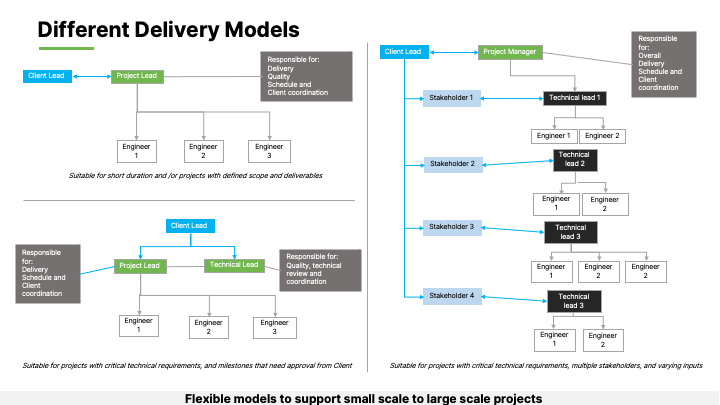In today's fast-paced business environment, clients expect high-quality products and services delivered quickly. This is true especially in the automotive industry because product development cycles are shrinking while automotive OEMS launch several vehicles every year. The extreme pressure for rapid delivery can lead to compromises in quality and strain on resources, impacting employee well-being. To effectively meet client expectations and ensure sustainable outcomes, businesses need to find the right balance between speed and quality.
A sustainable Global Delivery Model is essential to enhance efficiency and reduce costs by leveraging resources from different parts of the world. The critical factor is the availability of the required skilled resources at a lower cost to the business, to deliver high-quality services and products to customers.
The Global Delivery Model involves gathering customer requirements at the client site and executing projects with 24/7 availability of remote technical teams, whether onsite, nearshore or offshore.
Types of Delivery Models
Global delivery model can be better understood by understanding the essential locations from where service is delivered.
1. Onsite Delivery – Enabling effective project management through direct client engagement.
In this model, experts visit the client site, ensuring seamless interaction and a comprehensive understanding of the client's requirements, and existing systems and processes. This approach ensures seamless communication and facilitates superior project management and faster delivery.
2. Nearshore Delivery - Leveraging local expertise with remote work capabilities.
Consultants work remotely from the same city or country as the client, utilizing the benefits of onshore resources. This model may involve a combination of on-site and remote workers, offering flexibility and convenience while maintaining effective communication.
3. Offshore Delivery - Streamlining Project Activities at Remote Sites enabling 24/7 support cost effectively.
This model involves completing project activities at one or more offshore locations with the assistance of a dedicated outsourcing team. Assigning project or delivery managers at both the client and offshore sites ensures efficient project management.
4. Hybrid Delivery - Integrating Onsite, Nearshore, and Offshore model for Optimal Results.
The hybrid model combines the strengths of onsite, nearshore, and offshore models. It provides cost-effectiveness similar to offshore development while maintaining face-to-face contact for effective communication and project success.
Benefits of Global Delivery Model
The benefits of the Global Delivery Model are extensive.
- Continuous resource availability –
- Utilizes resources onsite / nearshore and offshore with effective daily handover with few hours overlap.
- Reduction in investment costs –
- Deploying resources onsite can help companies reduce investment cost as the resources can use client infrastructure. Similarly, offshore resources may be available at lesser cost leading to reduced overall investment.
- Multicultural working environment –
- Bringing resources from multicultural environment can boost innovation as there is high possibility to bring best practices from around the world.
- Better Return on Investment (ROI) -
- Global delivery model can help to increase value while reducing cost at the same time.
- Ability to customize projects –
- As there are resources available globally, companies have the flexibility to customize projects form different locations
- High customer satisfaction –
- Customers win on multiple levels – high engagement, lower cost and fast tracked development.
Goken's Global Delivery Model Helps Clients Reduce Costs and Increase ROI
Goken’s global delivery model is designed such that there is alignment with external customers as well as internal teams.
- Alignment with customer
Goken sets the expectation with clients by setting a clear communication structure for each project. As shown in figure below, there are multiple structures that could be used depending on the size and complexity of the project. Some of the examples are shown here. In the first example, the client lead coordinates with Goken’s project lead, who could be onsite or nearshore. Goken’s project leads works with engineers working onsite, nearshore or offshore. In another example, client lead coordinates with Goken project manager to set targets and expectations. Individual stakeholders from client side then coordinate with technical leads or engineers from multiple groups in Goken. - Goken Internal Alignment
Based on the size and complexity of the project, Goken chooses teams onsite, nearshore and offshore. Each of these teams have specific roles to play. Onsite engineers are client facing so they are highly experienced in understanding client requirements, preparing project plans, developing high level architecture and doing quality checks. The nearshore team focuses on development, day to day report preparation and ensures seamless communication with offshore and onsite. The offshore team is heavily geared toward concept design, detailed 3D and 2D development and close communication with all stakeholders. As shown in Figure 3, Goken America, Goken India and Goken Nihon work together to complete the 24 hour cycle to maintain project continuity.

